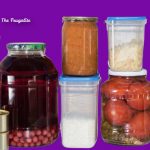(Psst: The FTC wants me to remind you that this website contains affiliate links. That means if you make a purchase from a link you click on, I might receive a small commission. This does not increase the price you’ll pay for that item nor does it decrease the awesomeness of the item. ~ Daisy)
Have you ever had a month when money is so tight you can’t imagine how you’re possibly going to feed your family? Then this is the article for you.
When your budget is super tight, grocery shopping is going to look a lot different. In my opinion, you’re better off to shop for the entire month all at once when times are tough. Once-a-month shopping is a far less expensive way to purchase food, and I do it myself even when things aren’t too bad.
Your diet may look a little different
When you are doing a flat-broke, once-a-month shopping trip, your diet may look a little different than it normally does. Remember, your goal is to get through the month without going hungry, not to go organic paleo.
Don’t plan on eating low-carb during a rough month. Unless, of course, you have a health condition that requires a low-carb diet, plan on adding more grains and starches to your diet during a rough spot.
Also, you probably won’t be able to eat organic. If you normally eat nothing but fresh, organic goodness, times that are tight are going to have to be different.
If times are really, really tight, you are going to need to loosen your standards to survive. If you are rock bottom broke, you may have to go even cheaper.
So, when I recommend canned fruits and lots of potatoes here in a minute, I don’t want to hear “But that’s not healthy!” Just make the best choices you can while still staying fed, okay?
Let’s go through our food groups really quickly to give you an idea what you’ll be looking for on your shopping trip.
None of these lists is comprehensive – you have to go with the things your family will eat and the things you can personally acquire inexpensively.
Protein
When you’re broke, protein is going to be the costliest part of your menu.
- Meat: When your budget is super tight, don’t expect meat to be the main dish. I’m not saying you have to go vegetarian, but calorie for calorie, meat is very expensive. Use less meat than you normally would and make it an ingredient instead of the star of the meal. Go with less expensive cuts and cook them for a long time: stew beef, 70/30 ground beef, chicken quarters, chicken thighs, etc., are much less costly. You can also buy an inexpensive beef roast and an inexpensive whole chicken that will get you through several meals if carefully doled out.
- Eggs: Eggs are a very inexpensive and healthy source of protein. Walmart has huge flats with 30 eggs for a very reasonable price. I suggest you grab a few of those and think about breakfast for dinner.
- Beans: I absolutely love beans and strongly recommend them. Proper soaking and rinsing can reduce the resulting flatulence that a lot of folks worry about. Go with dried beans instead of canned for greater savings. If your family members don’t like beans, they might prefer refried beans or bean dip. Worst case scenario, you can puree cooked beans and add them to a soup for a nutrient boost.
- Peanut butter: Peanut butter is a tasty protein source and most kids love it. (Assuming there are no allergies, of course.) Grab a huge jar and if possible, go for one that is more natural. Skippy and Jif both have a natural peanut butter without a whole lot of additives.
- Canned tuna: Beware of eating this stuff non-stop because of high levels of mercury, but some canned tuna will add much-needed protein to your menu. (Here are some awesome ways to eat tuna.)
- Lentils and split peas: Both of these are high in protein, dirt cheap, and easy to turn into delicious soups.
Fruits and Vegetables
Produce is a very important part of a healthy diet.
Without it, you’re at risk for all sorts of deficiency diseases. When shopping once a month, plan to eat your fresh stuff early in the month and then move on to your frozen or canned goods.
- Apples: If the price is reasonable, grab a large bag of apples. This will provide you with some fresh fruit.
- Applesauce: This is a great addition for later in the month when the fresh stuff is gone. To save money, look for large jars of applesauce instead of the little individual packets for lunch boxes. Go with unsweetened applesauce.
- Canned fruit: Get fruit canned in the lightest syrup possible, or fruit canned in juice. Just because you’re broke doesn’t mean you need to eat 10 pounds of sugar per day, right? Canned fruit is a nice addition to pancakes, waffles, or oatmeal. Reserve the juice for baking.
- Overripe bananas: If your store has a last-day-of-sale bin for produce, you may be able to grab some overripe bananas. Get these and take them home for banana bread.
- Carrots: I’m not talking about baby carrots here. I’m talking about those huge bags of grown-up carrots you’ll need to peel and slice yourself. Remember earlier when I told you that you’re either spending time or money? Carrots are a perfect example of that. Peel them, slice them, and keep them in a bowl of water in your fridge for yummy snacking.
- Potatoes: A couple of bags of potatoes can get you through a rough time. Potatoes are filling, can be cooked in a lot of different ways, and most folks love them. Leave the peel on for added fiber. Store them in a cool, dark place away from onions for the longest life. Even when they’re sprouting eyes, you can eat them though – just cut out the sprouting parts.
- Onions: A big bag of onions will help you flavor up your home cooking this month.
- Garlic: Sometimes it’s cheaper to buy garlic already chopped up in a jar. Grab enough garlic to spice up your food over the course of the month.
- Cabbage: Depending on the time of year, a few heads of cabbage will get you far for very little money. You can use cabbage in coleslaw, salads, soup, or casseroles. You don’t need to get fancy – just go with the plain, ordinary green heads of cabbage if they’re the cheapest.
- Canned tomatoes: My favorite canned good is canned tomatoes. I like to get a variety of crushed and diced ones. These can be used for soups, chili, casseroles, and sauces. Canned tomatoes are a nutritional powerhouse.
- Frozen vegetables: At my local grocery store, I can get bags of frozen vegetables for a dollar each, and sometimes less. If you have the freezer space, this is the way to go. I suggest you grab at least 30 bags of veggies that you know your family will enjoy. Our favorites are: peas and carrots, green peas, corn, cauliflower, broccoli, chopped spinach, Brussels sprouts, mixed vegetables, and green beans. With an assortment of frozen vegetables, you can make all sorts of great stuff.
- Whatever is in season: Every season, there are fruits and veggies that are at their ripest and least expensive. What is in season depends on when your personal financial catastrophe occurs.
Dairy
If you consume dairy products on a daily basis, you’re going to still want to consume dairy products when times are tough. (Cream for your coffee, milk for cereal, a beverage for the kiddos).
Generic milk by the gallon is your least expensive way to go for this. You can make all sorts of things from your gallons of milk, like homemade yogurt and cottage cheese. I suggest you put aside enough cash to be able to pick up a gallon of milk weekly. If you don’t already have powdered milk, this isn’t the time to buy it. It tends to be a lot more expensive than fresh milk.
Milk with lower fat can be frozen. Be sure to remove at least one cup of milk from your gallon jug to allow room for expansion. This works best with skim milk. Any milk with fat will need to be shaken each time you use it.
Grab cheese by the block for the least expensive option. Because we really enjoy cheese, I pick up 2 large blocks for a month. I cut each one in half and package them up separately. I freeze 3 and keep one in the fridge. Remember, cheese is a condiment during difficult times, not a main course. You simply cannot afford cheese and crackers for dinner.
Grains
I know this is a wildly unpopular ingredient these days, with all the low-carb and keto diets out there, but grains are the great stretchers of your pantry. You can take one serving of leftover chili and feed your entire family with it when you mix it with rice and a little bit of cheese.
Buy your grains in the biggest packages possible for the most savings. Forget about “instant” anything – these items are often totally stripped of nutrition, and again – you are spending time, or you are spending money. Here are some of the grains to look for:
- Brown rice
- Pasta
- Oats
- Quinoa
- Barley
- Flour
- Cornmeal
There are lots of other grains, but these are inexpensive, versatile, and easy to work with.
Basics
To turn your raw ingredients into meals, you’ll need a few scratch cooking basics, too.
- Baking soda
- Baking powder
- Yeast (if you are going to bake bread)
- Spices
- Sugar, Syrup, Honey
- Fats (Cooking oil, shortening, butter, lard, etc.) Vinegar
- Salt and pepper
How much should you buy?
This is the tricky part. How much to buy has a lot of variables and only you can identify them.
- What do you have on hand?
- How big is your family?
- How hungry is your family?
- How picky is your family?
- How long do you expect the budget to be tight?
The best option is to do some meal planning before you go shopping. This should help you identify how much you need for main meals. Don’t forget to add extra for lunches and snacks! Here’s what one person bought for under $20 at Walmart.
Want more information about shopping and cooking when times are tough? Check out The Flat Broke Cookbook in downloadable PDF or paperback.
How do you shop on the cheap?
When your budget is tight, what are your favorite shopping tips? Share them with your fellow Frugalites in the comments.












16 thoughts on “The Frugalite’s Guide to Flat Broke Grocery Shopping”
If you rinse your 70/30 meat in hot water it can remove a lot of the fat, though if I’m trying to keep everyone satiated, I might opt to keep the fat content higher.
Old fashioned oatmeal is a great frugal option. It makes a hearty breakfast by itself. Any leftover oatmeal can then be used to make bread. Ground oatmeal is a good substitute for breadcrumbs, flour, or as filler to stretch ground beef. Oatmeal can also be added to smoothies to bulk them up a bit. Ditto for adding to casseroles.
A common sense tip that has served me well over the years is to eat a large meal before grocery shopping. If I’m not hungry when I shop I’m far less likely to be enticed by impulse items, and can easily stick to my list.
This is already very similar to my grocery plan. Thanks for the “you’re on the right track” validation!
Shop the sale and clearance racks. Stock up on “on-sale” pantry items whenever you can. Soup is easy to make, filling, and a great budget stretcher: one diced pork chop with a hand full of vegetables in a pot of soup will feed a family of four.
Pick up foreign cookbooks, ex. my family is Ukrainian, which is mostly “peasant food” where people don’t have much in the ways of refrigeration, and use hearty and inexpensive ingredients in colorful ways e.g. cabbage, potatoes, onions etc. My favorite cookbook series is “Baba’s Kitchen.”
The next best tip is to cook in bulk and create mealplans that you can freeze and thaw out over time. Cook multiple mealplans in a week to be able to rotate so you don’t get sick of eating the same thing even though it may have a lot of the same ingredients.
I went through a period like this (flat broke shopping) almost 10 years ago, while I was getting a divorce. I moved into my own apartment and had a mortgage (on the house she was still staying in), rent for myself, and 2 sets of utilities. Oh yeah, and I was paying my lawyer and a chapter 13 bankruptcy as well. I had to work 2 jobs (sometimes 3) to survive. No internet (I took my laptop to where I could get WiFi once in a while), basic phone with a prepaid cell phone, etc. As for grocery shopping, I went to 3 stores in this order – Aldi, Dollar Tree, Walmart. Aldi first, where I (at the time) could pick up almost 2 weeks’ worth of food for about $35 or so (those were the days). I’d buy a loaf of bread, lots of canned and frozen, etc. Next, Dollar Tree, where everything is a buck. There, I would pick up a few canned goods (name brand, rather than the store brands that Aldi carried) and a few other cheap items. Finally, Walmart for coffee, peanut butter, and maybe a couple more items (you’ll have to excuse me, but I’m spoiled on decent coffee and name brand peanut butter – can’t stand the store brands or generics). Things are likely different now, but I was able to make it at the time and not starve.
I remember being so hungry. I had no money to buy food and two little mouths to feed. The only thing that fed us was prayer. A couple took us out after church to the nicest place in town. We had leftovers for afterwards. I can remember not being able to find a job anywhere. I tried. I tried hard. I remember I thought about asking the grocer for bones. I was so afraid to. I wondered if you could eat dandelions. There was a field of them. But it was before the internet and I didn’t know if they were poisonous or not. We ended up moving to be with my parents. When I was finally on my feet with a job, I went back and shopped at the same grocery store that I only wished I could shop at. It felt so good to buy what I wanted.
Thank you thank you thank you. You have the guts to say enough with keto, paleo and organic. Thank you for telling it like it is.
I was surprised to find I’m doing a lot from your article. Eggs, beans, oats, rice, fresh apples, bananas, and potatoes. Canned fruit and frozen vegetables. My splurge is on plain Greek yogurt, 4% cottage cheese, blocks of cheese, and butter, but I make them last. Plus soy milk for the oats. I freeze cheese and butter. This is a complete list of what I eat. I get by on $65 per month for one person. Things like beans, grains, and canned goods don’t have to be bought every month.
I was so excited to hear you talk about only shopping once a month. Not sure why, but you absolutely get more for your money shopping monthly. Thank you so much for your articles.
Ordinary Complete Pancake Mix, baked in a skillet as a cake with a can of peaches including the juice tastes amazing. Grease with butter. Put the peaches in a skillet or baking dish, then pour the pancake mix over it. Bake until it smells and looks done.
Thank you for this good idea.
Sounds like we shop much alike. Staples here are pasta, beans, and rice. Fill in and change with vegetables and bits of meats. I do have dry milk on hand. It a beverage, a gravy ingredient, the base of yogurt and cottage cheese. I collected old cookbooks learning what goes together and how to stretch ingredients. Now I give away cookbooks to new preppers and teens learning to cook. Good simple food is satisfying and filling. A variety of fruits and vegetables is basic to supporting health.
When things were tight I tried to satisfy all the different tastes at supper (our big meal of the day). The main dish might be soup, but I added something sweet and something tooth-some to the meal. It might be Jello with a thinly sliced apple suspended in it and a batch of homemade biscuits with butter and jam. The meal satisfied, and left you without the feeling that something was missing. We raised 4 kids at home and paid child support for another. My husband was on disability for 4 years and I worked part-time while homeschooling. I learned to can and freeze food, cook from scratch and make due with what we had.
I haven’t heard anyone mention dumpster diving in this article.I do know someone that has. This person worked in some of the finest restaurants in NYC and told me that some of the food still packaged had nothing wrong with it but they had a rule if it was past the expiration date they would throw it away.Even a major Pharma chain would throw food and holloween candy away rather than discount it to employees because they wouldn’t get to write it off their taxes as a loss now that’s pretty sad.Also we’ve seen on tv milk being dumped on the side of the road.
The first commenter mentioned using leftover oatmeal in bread. Good suggestion and it eliminates waste. Along those same lines, we make extra when cooking grits or rice. I like a bowl of rice with toast for breakfast. Then it can be used with beans for a chipotle type bowl or stir fry. If it’s going to be more than a couple of days, freeze it. We save leftover grits for frying with chopped onions and jalapenos, or baking with cheese and jalapenos and an egg. Leftover boiled potatoes can be chopped for hash browns or added to vegetable soup. Keep a quart sized jar in the freezer for leftover vegetables for soup.
Soft apples (not mushy) can be made into applesauce or applebutter. When I’ve let strawberries go too long for eating fresh, I cut them up (trimming off any bad places) and add their equal weight in sugar and cook slowly. Do not add water. Cook slowly and stir constantly for about 15 minutes. It makes much more delicious jam than the commercial kind.
I should’ve noted that my account of making strawberry jam is NOT for canning.. It’s for whatever is left from a box from the grocery store and will make 1 jar or less. So, I don’t do all the sterilizing because the jar is going into the refrigerator and will be eaten in less than a week. Also, my jars all go through the dishwasher, so there is that bit of sterilization.
Just don’t want anyone getting sick.
I put leftover cream of wheat into pancakes. My children loved them.
Debbie in MA